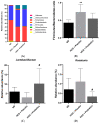Anti-Obesity Effects of Multi-Strain Probiotics in Mice with High-Carbohydrate Diet-Induced Obesity and the Underlying Molecular Mechanisms
- PMID: 36501204
- PMCID: PMC9739441
- DOI: 10.3390/nu14235173
Anti-Obesity Effects of Multi-Strain Probiotics in Mice with High-Carbohydrate Diet-Induced Obesity and the Underlying Molecular Mechanisms
Abstract
Overconsumption of highly refined carbohydrates contributes significantly to the current obesity pandemics. Probiotic administration protects against weight gain in animals fed a high-fat diet (HFD). Nonetheless, the anti-obesity effects of probiotics in a high-carbohydrate diet (HCD)-induced obesity models are not well elucidated. Herein, C57BL/6N male mice were fed an HCD (70% kcal carbohydrate) for 12 weeks and were orally treated with multi-strain probiotics (MSPs) at 1010 CFU or saline every day for 6 weeks. MSPs contained Lactobacillus acidophilus DSM 24936, Lactiplantibacillus plantarum DSM 24937, and Limosilactobacillus reuteri DSM 25175. MSPs treatment not only ameliorated weight gain but also modulated the body fat composition altered by HCD. The MSPs also attenuated the expression of adipogenesis- and lipogenesis-related genes in HCD-fed mice. In addition, MSPs promoted the expression of lipolysis- and fatty acid oxidation-promoting factors in HCD-fed mice. Furthermore, MSPs modulated the expression of thermogenesis-related genes and the serum levels of obesity-related hormones altered by HCD. Treatment with MSPs positively reversed the Firmicutes/Bacteroidetes ratio, which is associated with a risk of obesity. Hence, this study explores the multifaceted anti-obesity mechanisms of MSPs and highlights their potential to be used as effective weight-management products.
Keywords: Firmicutes/Bacteroidetes ratio; high-carbohydrate diet; obesity; probiotics.
Conflict of interest statement
CH Labs Corp. is a subsidiary company of CKD Healthcare (Seoul, Republic of Korea).
Figures









References
-
- Nam G.E., Kim Y.-H., Han K., Jung J.-H., Rhee E.-J., Lee S.-S., Kim D.J., Lee K.-W., Lee W.-Y., on behalf of the Taskforce Team of the Obesity Fact Sheet of the Korean Society for the Study of Obesity Obesity Fact Sheet in Korea, 2019: Prevalence of Obesity and Abdominal Obesity from 2009 to 2018 and Social Factors. J. Obes. Metab. Syndr. 2020;29:124–132. doi: 10.7570/jomes20058. - DOI - PMC - PubMed
MeSH terms
Substances
Grants and funding
LinkOut - more resources
Full Text Sources
Medical

